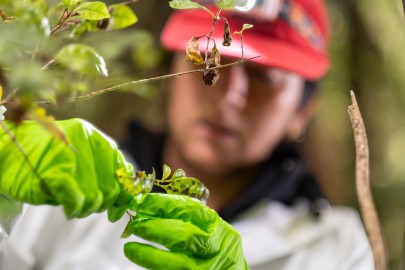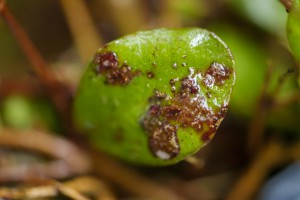
Senior Researcher Mahajabeen Padamsee counts leaves on a ramada tree in Egmont National Park
The day boasted 16 talks on a variety of topics – including potential biocontrol agents, environmental drivers of myrtle rust infection, kaitiakitanga and Māori-led solutions, disease behaviour, and the management of myrtle rust in natural areas. Presenters and attendees hailed from Crown Research Institutes, research organisations, iwi, government organisations, and universities. There were also two student presentations, one on seed-borne endophytes of pōhutukawa and one on the importance of aka vines to Māori.
The diversity of the topics and organisations represented at the meeting highlighted what Programme Leader and Manaaki Whenua Senior Researcher Dr Mahajabeen Padamsee calls one of the most critical successes of both the programme and of myrtle rust research generally in Aotearoa New Zealand: collaboration. “The work presented has been reliant on past work and on continued collaborations with colleagues across New Zealand and Australia, who are all passionate about protecting our myrtles,” says Maj.
This sentiment was echoed by attendee and speaker Dr Beccy Ganley, principal scientist at Plant & Food Research and leader of the national programme Ngā Rākau Taketake, which is administered by the New Zealand’s Biological Heritage National Science Challenge. “Being part of myrtle rust research has been the best example of collaboration I have experienced so far in my career and an exemplar of how research should be done in New Zealand,” says Beccy.
Beyond Myrtle Rust will conclude in June 2024, but researchers will be sharing everything they’ve learned over the course of the programme on social media in the months to come. If you’re curious about their outputs, please follow them on Twitter/X, Instagram or Facebook.


